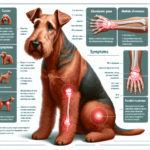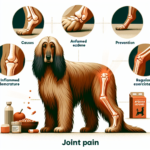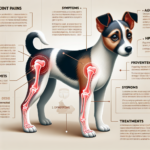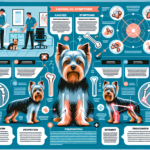Welsh Terrier Joint Pain: Causes, Symptoms, Prevention, and Treatment

Introduction
The Welsh Terrier is a spirited and intelligent breed known for its distinctive appearance and lively personality. Originating from Wales, this breed was initially developed for hunting foxes, badgers, and other small game. With a history dating back to the 18th century, Welsh Terriers have become beloved companions and show dogs, admired for their wiry coat, expressive eyes, and robust build.
Like many breeds, Welsh Terriers are prone to certain health issues, with joint pain being a significant concern. Joint health is crucial for maintaining the breed’s active lifestyle and overall well-being. Understanding the causes, symptoms, prevention, and treatment of joint pain in Welsh Terriers can help owners ensure their pets lead healthy, pain-free lives.
Breed-Specific Joint Pain Risks
Genetic Predisposition
Welsh Terriers, like many purebred dogs, can be genetically predisposed to joint-related issues. Common conditions include hip dysplasia, elbow dysplasia, and arthritis. Hip dysplasia occurs when the hip joint doesn’t fit properly into the hip socket, leading to pain and mobility issues. Elbow dysplasia involves abnormal development of the elbow joint, causing lameness and discomfort. Arthritis, a degenerative joint disease, can develop as a result of these conditions or independently, leading to chronic pain and stiffness.
Age-Related Risks
As Welsh Terriers age, the risk of joint pain increases. While young dogs may show early signs of genetic joint issues, older dogs are more likely to develop arthritis and other degenerative conditions. Owners should be vigilant about joint health as their Welsh Terrier reaches middle age, typically around 5-7 years old, and continue monitoring into their senior years.
Activity Level and Joint Stress
Welsh Terriers are known for their high energy levels and love of physical activity. While regular exercise is essential for their overall health, excessive or inappropriate activity can put stress on their joints. Activities like jumping, running on hard surfaces, or intense play can exacerbate joint issues, especially in dogs with a genetic predisposition. Balancing exercise with rest and providing appropriate activities can help mitigate joint stress.
Common Symptoms of Joint Pain in Welsh Terriers
General Symptoms
Owners should watch for common symptoms of joint pain in their Welsh Terriers, including:
- Limping or favoring one leg
- Stiffness, especially after rest or exercise
- Reluctance to jump, climb stairs, or engage in usual activities
- Decreased activity level or lethargy
- Visible discomfort or pain when touched
- Swelling around the joints
Breed-Specific Symptoms
While the general symptoms of joint pain apply to Welsh Terriers, owners may notice specific behaviors or signs unique to the breed. Welsh Terriers are known for their tenacity and may try to hide their pain, continuing to be active despite discomfort. Subtle changes in behavior, such as increased irritability or reluctance to play, can be early indicators of joint pain.
When to Consult a Vet
If any of the above symptoms are observed, it is crucial to consult a veterinarian promptly. Early diagnosis and intervention can significantly improve the quality of life for a Welsh Terrier with joint pain. Regular veterinary check-ups are also essential for monitoring joint health and catching issues early.
Preventive Measures for Joint Health
Exercise Recommendations
Maintaining an appropriate exercise routine is vital for the joint health of Welsh Terriers. Low-impact activities such as walking, swimming, and controlled play are excellent options. Avoiding high-impact exercises like jumping or running on hard surfaces can help reduce joint stress. Consistent, moderate exercise helps maintain muscle strength and joint flexibility.
Dietary Suggestions
A balanced diet rich in essential nutrients supports joint health. Foods containing glucosamine, chondroitin, and omega-3 fatty acids can help maintain joint function and reduce inflammation. Owners may consider supplements specifically designed for joint health, but it is essential to consult a veterinarian before adding any supplements to the dog’s diet.
Weight Management
Maintaining a healthy weight is crucial for reducing joint stress in Welsh Terriers. Excess weight puts additional pressure on the joints, exacerbating pain and mobility issues. Owners should monitor their dog’s weight and adjust their diet and exercise routine as needed to keep them at an optimal weight.
Early Screening and Monitoring
Regular veterinary check-ups and early screening for joint issues can help catch problems before they become severe. X-rays, physical exams, and genetic testing can identify predispositions to joint conditions. Early intervention strategies, such as lifestyle adjustments and preventive treatments, can significantly improve long-term joint health.
Treatment Options for Joint Pain
Non-Surgical Treatments
Non-surgical treatments for joint pain in Welsh Terriers include:
- Medications: Anti-inflammatory drugs, pain relievers, and joint supplements can help manage pain and inflammation.
- Physical Therapy: Exercises and therapies designed to improve joint function and reduce pain.
- Lifestyle Adjustments: Modifying activity levels, providing supportive bedding, and using ramps can help reduce joint stress.
Surgical Options
In severe cases, surgical intervention may be necessary. Common surgeries for joint pain include:
- Hip Replacement: Replacing the damaged hip joint with an artificial one.
- Arthroscopy: A minimally invasive procedure to clean out the joint and remove damaged tissue.
- Joint Fusion: Fusing the joint to reduce pain and improve stability.
Surgical options should be discussed with a veterinarian to determine the best course of action for the individual dog.
Alternative Therapies
Alternative therapies can complement traditional treatments and provide additional relief. Options include:
- Acupuncture: Using needles to stimulate specific points on the body to reduce pain and inflammation.
- Hydrotherapy: Water-based exercises that reduce joint stress while improving strength and mobility.
- Massage: Therapeutic massage to improve circulation, reduce pain, and promote relaxation.
Lifestyle and Management Tips
Daily Care Routine
A sample daily care routine for managing joint pain in Welsh Terriers might include:
- Morning: Gentle walk or swim to start the day with low-impact exercise.
- Midday: Administer any prescribed medications or supplements.
- Afternoon: Short play session with toys that do not require jumping or intense running.
- Evening: Another gentle walk or physical therapy exercises.
- Night: Ensure the dog has a comfortable, supportive bed for rest.
Modifying the Home Environment
Making the home more comfortable for a dog with joint pain can significantly improve their quality of life. Consider the following modifications:
- Install ramps or steps to help the dog access furniture or vehicles without jumping.
- Provide orthopedic beds that offer better support for joints.
- Keep food and water dishes at a comfortable height to reduce strain.
- Ensure floors are non-slip to prevent falls and injuries.
Long-Term Management
Long-term management of joint pain involves ongoing monitoring and adjustments. Regular veterinary check-ups, maintaining a healthy weight, and adapting exercise routines as needed are essential. Owners should stay informed about new treatments and therapies that may benefit their dog.
FAQs About Welsh Terriers and Joint Pain
What are the early signs of joint pain in Welsh Terriers?
Early signs include limping, stiffness, reluctance to move, and changes in behavior such as irritability or decreased activity levels.
Can joint pain in Welsh Terriers be prevented?
While genetic predispositions cannot be entirely prevented, maintaining a healthy weight, providing appropriate exercise, and regular veterinary check-ups can help reduce the risk and severity of joint pain.
Are there specific diets that can help with joint health?
Yes, diets rich in glucosamine, chondroitin, and omega-3 fatty acids can support joint health. Consult a veterinarian for specific dietary recommendations.
When should I consider surgery for my dog’s joint pain?
Surgery should be considered when non-surgical treatments are no longer effective, and the dog’s quality of life is significantly impacted. A veterinarian can help determine the best course of action.
What alternative therapies are effective for joint pain in Welsh Terriers?
Alternative therapies such as acupuncture, hydrotherapy, and massage can provide additional relief and complement traditional treatments.
Conclusion
Joint pain is a common concern for Welsh Terriers, but with proper understanding and management, owners can help their pets lead comfortable and active lives. By recognizing the symptoms, taking preventive measures, and exploring various treatment options, owners can ensure their Welsh Terriers maintain optimal joint health. Regular veterinary consultations and a proactive approach to joint care are essential for the well-being of this spirited and beloved breed.




